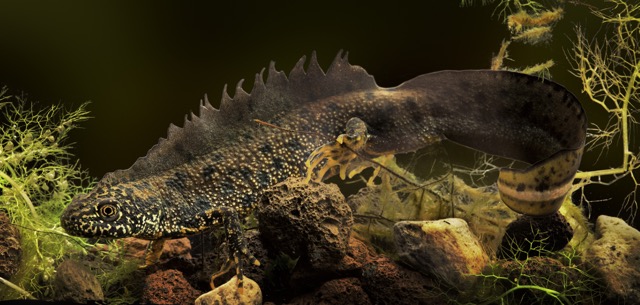
For 2024, our calendar features watercolour illustrations of UK wildlife by Alexia Claire. To go alongside this, we'd like to tell you more about the plants and animals we chose to feature each month. For July 2024 our species of the month is the Great Crested Newt (Triturus cristatus).
How to identify a Great Crested Newt
Great Crested Newts are one of the UK's three newt species. It is also known as the Northern Crested Newt and Warty Newt. They can be easily distinguished from the others by their much larger size, measuring 15-18cm compared to 7-10cm for Smooth and Palmate Newts. They have rough, warty skin that is very dark, near black, in colour which contrasts with their spotted bright orange-yellow bellies. During the breeding season in Spring, Males also sport a prominent, jagged crest along their back and tail which is used for courtship in a display for the females.
The females lay around 200 eggs which are individually wrapped in vegetation. Their tadpoles, featuring frilly gills, will develop into young newts over the course of a few months, emerging on land around August.
Where are Great Crested Newts found?
Great Crested Newts are found throughout the UK, with a more limited presence in Scotland. They are generally not found in Devon, Cornwall or west Wales. The adults are terrestrial most of the year, sheltering during the day among the leaf litter, logs, stones and burrows in damp woodland, hedgerows and boggy grassland. They hibernate underground during the winter, and in Spring will emerge and travel to water to breed. They prefer still, or slow moving mid to large ponds with dense vegetation on which they lay their eggs, and which are free of fish which predate on eggs and tadpoles. They will generally return to the same pond each year.
Adults will leave once they have laid eggs. Their tadpoles, featuring frilly gills will grow their legs and develop into young newts, or efts, to emerge on land around August.

What do newts eat?
The diet of Great Crested Newt changes throughout the year, depending on their environment, though they are carnivorous and mainly feed on small invertebrates. When in ponds this includes water fleas, water beetles, mosquito larvae and aquatic worms. They are also known to feed on the eggs and tadpoles of other amphibians.
During their time on land, this changes to ants, beetles, caterpillars, small snails, millipedes and centipedes.
How can we help protect them?
Great Crested Newts benefit from UK and European protection through the Wildlife and Countryside Act (1981), the Conservation of Habitats and Species Regulations (2017) and EU Habitats Directive. This is due to many factors, including their importance as an indicator species, habitat fragmentation and their susceptibility to aquatic habitat loss, pollution and the introduction of fish.
Great Crested Newt populations benefit from habitat protection and restoration of both aquatic and terrestrial environments. This includes; avoiding pollution and eutrophication of water bodies by minimising agricultural runoff and using environmentally friendly practices; ensuring connectivity between aquatic and terrestrial habitats to facilitate newt movement and migration and creating ponds have a variety of depths, which are free from fish and have abundant vegetation.
Monitoring GCN populations are a key in determining the efficacy of our current mitigation methods, and assessing trends. Methods such as pond surveys, pitfall traps, and eDNA analysis are used to track changes and you can find out more about methods in our Great Crested Newt Guide blog.
Through community engagement and advocacy we can promote the continued conservation of Great Crested Newts. Charities like Amphibian and Reptile Conservation (ARC) and Froglife work on habitat restoration projects around the UK and conduct surveys to gather population data. The Amphibian and Reptile Groups of the UK (ARG UK) promotes the conservation of herpetofauna by supporting a network of independent local groups. If you'd like to help Great Crested Newts and other amphibians - get involved!



